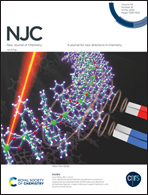Role of alkali charge compensation in the luminescence of CaWO4:Nd3+ and SrWO4:Nd3+ Scheelites†
Abstract
This work presents a new perspective on alkali metal co-doped rare earth based-phosphors in understanding the distinct role of 3 different alkali metal co-dopants, Li+, Na+ and K+, with the excitation of host and rare earth dopant. The system under investigation is the technologically important Scheelite host and NIR-emitting Nd3+ ion. The Li+ ion was found to improve the crystallinity and reduce the symmetry more efficiently than act as a sensitizer in aiding the host to dopant energy transfer, which results in more emission output from the Nd3+ excitation in comparison to the host. We could also successfully compare the optical output of CaWO4:Nd3+ and SrWO4:Nd3+ Scheelite with and without alkali metal ions in terms of the peak shift and intensity by considering the greater lattice dimensions of the latter when compared to the former. For the larger SrWO4:Nd3+ lattice, K+ and Na+ were found to be better co-dopants in enhancing the NIR emission under the host and Nd3+ excitation, respectively, compared to the smaller Li+ ion. The smaller unit cell dimensions of CaWO4 might facilitate more efficient energy and relaxation processes, making its excited state lifetime shorter in comparison to that of doped SrWO4. For alkali ion co-doping, a higher PL lifetime was observed for Li doping in the case of CaWO4 and Na co-doping in the case of SrWO4 under Nd3+ excitation, which is well in line with the NIR emission spectroscopy. Positron annihilation lifetime spectroscopy suggested the formation of cation vacancies and other associated vacancy clusters in the Nd3+ aliovalent doped CaWO4. Li+ does not act as a charge compensator for the removal of cation vacancies created by Nd3+ substitution in the Ca lattice. On the other hand, Na+ and K+ act as good charge compensators in Nd3+ doping in terms of vacancy removal. This work is highly relevant in understanding the role of alkali co-doping in both the luminescence properties and formation of defects to produce efficient Scheelite-based NIR phosphors.



 Please wait while we load your content...
Please wait while we load your content...